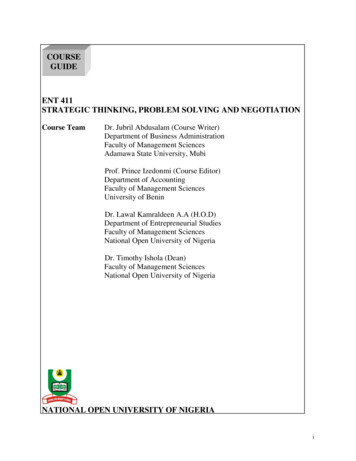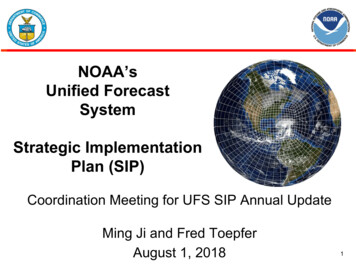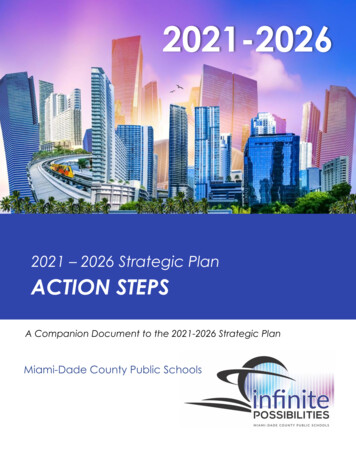
Transcription
2021-20262021 – 2026 Strategic PlanACTION STEPSA Companion Document to the 2021-2026 Strategic PlanMiami-Dade County Public Schools
Summary of Pillars & PrioritiesPillar IRelevant, Rigorous, &Innovative AcademicsPillar IIEnsure that allstudentsgraduate witha relevant,viable postsecondaryplan.Eliminate theachievementgap whileaccelerating allstudents to theirfull academicpotential.Pillar IIIHighly Effective Teachers,Leaders, & StaffPillar IVInformed, Engaged, &Empowered StakeholdersRecruit andretain the mostqualifiedemployees.Develop aculturallyresponsive andhigh-performingworkforce.Enhance anddiversifycommunicationstrategies tostrengthenstakeholderunderstanding.Improve andamplifymeaningfulPillar VMaintain theDistrict’s strongfinancialposition.Provideequitableaccess toquality ratorsas effectiveleaders ofhuman capital.Provide a safe,secure, andcleanenvironment forall Districtstudents, staff,and visitors.Safe, Healthy, & SupportiveLearning EnvironmentsPromote thephysical,emotional, andmental health ofstudents andemployees withinand beyondschool.two-waycommunicationwithstakeholders toensure equityand access.Provide thenecessarysupports topromotestudent accessandengagement.Empower allstakeholders tobe activeparticipants andadvocates inpublic education.Effective & SustainableOperational PracticesEnsure efficientand ng/procurementpractices.Establish andimplementsustainabilitypractices.2 M-DCPSinfinite Possibilities 2021-2026 Strategic Plan Action Steps
Pillar I Priorities, Objectives & Action StepsPriority 1 Ensure that all students graduate with a relevant, viable post-secondary plan.Objective 1: Ninety-five percent of high school students will obtain a standard diploma. Deploy a new portal report for students and parents to monitor progress towards graduation.Utilize and apply early warning indicators beginning in a student’s freshman year to ensure he/she is on-track tograduate by monitoring the progress of students by subgroups and proactively intervene when students showearly signs of attendance, behavior, or academic problems.Provide intensive academic support to students who are off-track and face significant challenges to academicsuccess through academic advisement, intensive courses, and/or extended learning opportunities.Expand collaboration among high school counseling teams, ESE (Exceptional Student Education) teams, andTransition Specialists to ensure that students with disabilities are maximizing opportunities to graduate with astandard diploma and implementing a post-secondary plan.Support high schools’ use of a comprehensive college and career planning tool (SCOIR) to ensure studentshave a post-secondary plan.Continue to create half-credit and full-credit recovery options for secondary students to meet graduationrequirements.Monitor course offerings at alternative education sites to ensure students meet graduation requirements.Add financial literacy to the required topics of study in the Student Progression Plan for grades K-12, includefinancial literacy lessons in the social science pacing guides at all grade levels, and provide professionaldevelopment to teachers.Objective 2: Increase the percentage of graduating seniors earning one college or career credit to at least 80%. Promote college/career readiness in middle school and high school through professional development oncollege readiness, student progression, diploma pathways, Career and Technical Education (CTE)pathways/stacking of credentials, and career planning for middle school, K-8, and high school counselors.Increase Career Dual Enrollment opportunities for students in CTE programs by expanding course offerings at ourseven technical colleges that meet the clock-hour acceleration state requirements.Collaborate with colleges/universities/technical colleges to offer teacher/counselor training to build awarenessof the career pathways from middle school to post-secondary being provided at these entities.Align school-site CTE course offerings to labor market demand and promote CTE programs through studenttestimonials.Provide Advanced Placement (AP), Cambridge (AICE), International Baccalaureate (IB) and Dual Enrollment(DE) teachers, counselors, and coordinators with ongoing professional development on strategies for increasingstudent participation and achievement in these courses.Provide AP, IB, and AICE students with Student Curriculum Review sessions to provide strategies and tips forincreasing achievement on AP/IB/AICE course exams.Expand Dual Enrollment opportunities by increasing DE partnerships and offering a variety of DE options,including courses on the high school campus, facilitated online models, courses on the college/universitycampus, and online/virtual/blended DE courses during the school year and summer term.infinite Possibilities 2021-2026 Strategic Plan Action Steps3 M-DCPS
Pillar I Priorities, Objectives & Action StepsPriority 2 Eliminate the achievement gap while accelerating all students to their full academic potential.Objective 1: Increase the percentage of students achieving on or above grade-level performance on stateassessments in English Language Arts, Mathematics, Algebra I, Geometry, Science, and Social Studies by at least 10percentage points per content area. Develop and implement an annual professional development plan for teachers and administrators thataddresses the needs of students and promotes quality instructional practices.Implement a progress monitoring system to ensure that all standards are taught and assessed for mastery;ensure that data generated is utilized for differentiating instruction that includes remediation and acceleration.Assist school-site administrators with data analysis to ensure that data chats with instructional staff are intentionaland purposeful.Provide targeted, job-embedded support to schools based on data.Promote student participation in District, state, national, and international academic competitions andenrichment initiatives.Objective 2: Narrow the achievement gap by increasing the percentage of underperforming subgroups achievingon or above grade level assessments in English Language Arts and Mathematics by 25 percentage points. Redesign the pedagogical approaches to providing instruction and remediation in ELA and Math forunderperforming students.Provide professional development to ELA, Reading, and Math teachers on culturally responsive teaching as wellas strategies for setting a classroom culture of high expectations, increasing student engagement, developinggrade-appropriate assignments, and delivering strong instruction.Expand early childhood programs across the District to address foundational reading and numeracy skills asearly as possible (Kindergarten readiness).Refine the utilization of District data tools to progress monitor student performance, analyze data results bysubgroups, and develop actionable instructional strategies to address academic needs.Provide training and additional resources to school sites to support the implementation of the Multi-Tiered Systemof Support (MTSS).Engage parents as partners and provide them with information on student progress and how they can help athome to improve student academic performance.Expand whole system supports through community partnerships that provide services to students which addresssocio-economic needs, academic support, and SEL systems in order to extend our reach and remove barriers tolearning associated with poverty and marginalization.Objective 3: Reduce the percentage of long-term English Language Learners in the English for Speakers of OtherLanguages program by 5 percentage points. Develop and implement annual professional development for ELA/ESOL K-12 teachers on evidence-basedmethods of addressing the needs of English Language Learners (ELLs).Promote quality instructional practices through the development of instructional pacing guides that embed theWIDA Can Do Descriptors as well as the state standards.Provide training for school site administrators and ESOL Liaisons on guidelines for monitoring, evaluating, andaddressing the needs of long-term ELLs.Enhance guidance documents for school site leaders on best practices in scheduling ELLs within the ESOLprogram.Utilize the Bilingual Parent Outreach Program (BPOP) to communicate with ESOL students and families aboutDistrict academic programs related to college and career options as well as extra-curricular activities.4 M-DCPSinfinite Possibilities 2021-2026 Strategic Plan Action Steps
Pillar I Priorities, Objectives & Action StepsPriority 2 Eliminate the achievement gap while accelerating all students to their full academic potential.Objective 4: Increase the percentage of M-DCPS Voluntary Prekindergarten (VPK) Program students that score readyfor kindergarten by 10 percentage points. Provide professional development to all stakeholders on the new screening and VPK progress monitoringprogram.Develop data chat protocols to be used with administrators, instructional staff, and families.Provide Pre-K teachers with curriculum support on standards-aligned instruction.Implement strategic monitoring and tiered support for continuous progress of all learners.Objective 5: Increase the inclusion rate of students with disabilities into mainstream classrooms by 10 percentagepoints. Monitor the inclusion rate and share information systematically with District, region, and school-site personnelmonthly.Tier schools by inclusion rate, percentage of ESE students coupled with percent within exceptionality subgroupsand provide monthly technical support visits and development for schools below the District average.Develop inclusion action plans for schools below the District average that are designated Tier 3 Least RestrictiveEnvironment (LRE) schools.Provide professional development sessions for teachers in partnership with the Florida Inclusion Network (FIN) ona monthly basis.Analyze exceptionality data monthly to identify patterns in the over identification of exceptionalities by race,ethnicity, and gender (disproportionality) and share with schools/regions.Develop and implement a District action plan to decrease disproportionality in exceptionalities by subgroup.infinite Possibilities 2021-2026 Strategic Plan Action Steps5 M-DCPS
Pillar I Priorities, Objectives & Action StepsPriority 3 Provide equitable access to quality and innovative instructional programs.Objective 1: Improve school performance to ensure 100% of District schools earn or maintain a grade of C or betteras determined by Florida’s School Accountability Program. Monitor the progress of student performance by analyzing and reviewing quantitative data on formativeassessments (i-Ready Diagnostics, Mid-year Assessments, and topic assessments).Utilize the District Support Formula to identify and provide support to selected schools (Tier 1 Watch, Tier 2, andTier 3).Promote a culture of continuous improvement to ensure sustainable practices through the School ImprovementProcess.Offer extended learning opportunities to mitigate learning loss and regression in the areas of reading, math,science, and social studies.Provide timely and relevant professional development for stakeholders on evidenced-based practices andhigh-yield, high-impact strategies.Utilize the District Support Formula to target schools for the allocation of additional funding, personnel, andresources.Utilize multiple measures, including growth measures, to inform improvement and accountability inunderperforming groups.Employ the Multi-Tiered System of Support (MTSS) to integrate academic and behavior interventions as thedriving mechanism for improving student outcomes.Expand partnerships that provide in-class support to students across all grade configurations.Objective 2: Increase magnet program enrollment across the District by 10%. Increase the number of magnet program offerings throughout the District’s elementary and K-8 schools.Identify programs with the greatest interest/demand in order to replicate those programs in other schools andareas of the District.Provide targeted marketing, recruitment strategies, and support to under-enrolled magnet programs.Provide technical workshops for magnet school administrators and lead teachers that focus on marketing,recruitment, onboarding, and retainment strategies that result in increased enrollment.Increase magnet transportation options as possible.Objective 3: Increase the number of students that participate in District pre-school programs by 10%. Monitor school needs and waitlists for Pre-K programs and identify opportunities for expansion across all Regions.Open additional Pre-K classrooms based on waitlists, funding, and available classroom space.Include community-based organizations and other partners in recruitment communications.Promote the District’s Early Childhood Programs via various platforms and community forums.Support school administrators with leading early learning best practices to strengthen the primary gradecontinuum of learning environment and family engagement.Conduct monthly in-person and virtual community outreach recruitment efforts.Objective 4: Increase the number of secondary students enrolled in computer science courses by 10%. Embed computer literacy skills and computational thinking across the curriculum in elementary classrooms toexpand access and strengthen computer science pathways at the secondary level.Provide professional development to elementary school teachers in computational thinking.Provide opportunities for teachers at all grade levels to obtain state certification in computer science.Explore partnerships to increase and enhance computer science offerings at all grade levels.Promote robotics and coding clubs/competitions at all grade levels.Promote student participation in college-level Computer Science courses (including AP, IB, AICE, and DEcourses).6 M-DCPSinfinite Possibilities 2021-2026 Strategic Plan Action Steps
Pillar I Priorities, Objectives & Action StepsPriority 3 Provide equitable access to quality and innovative instructional programs.Objective 5: Increase the percent of students who graduate with a Florida Seal of Biliteracy to 20%. Develop a District brochure and a website page to inform students and parents of the Florida Seal of Biliteracyguidelines and criteria.Have School Counselors emphasize the criteria for earning the Florida Seal of Biliteracy when conductingarticulation meetings with students entering secondary schools.Conduct informational meetings and parent webinars to provide details on the requirements for earning aFlorida Seal of Biliteracy as well as the benefits of biliteracy skills for a global society.Expand opportunities for students to participate in foreign language programs.Objective 6: Increase the number of students enrolled in Career and Technical Education (CTE) courses by 5%. Build awareness by developing CTE Program infographics that are research-based and capture career clusters,labor market demand, salary, education needed, and future market trends.Promote CTE programs to under-represented populations and increase gender equity across programs.Ensure that career pathway programs are implemented with fidelity to high industry standards and haveequitable student access to the curriculum, academic experiences, work-based opportunities, and internshippreparation for college and careers.Objective 7: Increase enrollment of underrepresented subgroups in advanced academic course offerings,including gifted, by 5 percentage points. Analyze student enrollment in advanced academic course offerings by subgroup.Provide targeted support to schools with populations that are underrepresented and/or underperforming inadvanced academic course offerings.Conduct professional development for all stakeholders on the identification of underrepresented students forgifted and advanced academic programs and the benefits provided by participating in these programs.Administer non-verbal ability tests to screen potential students for the gifted program.Increase the training on and use of culturally and linguistically responsive gifted evaluation instruments to betteridentify underrepresented students for gifted education.Ensure that all senior high schools offer a minimum threshold of AP/IB/AICE/DE courses.Expand dual enrollment course offerings at targeted sites through new partnerships that augment courseofferings beyond those available through local post-secondary partners.Expand dual enrollment opportunities at schools with limited DE offerings through increased credentialing ofteachers and facilitated online courses co-taught by university professors and high school teachers.Objective 8: Promote universal digital literacy by accelerating the integration of digital resources into teaching andlearning as demonstrated by an increase in the District’s 2024 digital resource capacity accreditation rating fromNeeds Improvement to Meets or Exceeds Expectations. Provide professional development opportunities for instructional and administrative staff to attain the technicalskills necessary to effectively implement and manage the Learning Management System (LMS) platform at theclassroom and school level, respectively.Form a teacher steering committee to guide and inform LMS configuration decisions.Provide targeted professional development for instructional and administrative staff on how to increase studentengagement and measure student progress using technology tools.Coordinate and deploy digital resources and associated professional development on the effective use ofthose resources in classroom instruction.infinite Possibilities 2021-2026 Strategic Plan Action Steps7 M-DCPS
Pillar II Priorities, Objectives & Action StepsPriority 1 Provide a safe, secure, and clean environment for all District students, staff, and visitors.Objective 1: Increase the overall school passage rate on sanitation audits/health inspections to 95%. Guide the work and training of custodians and administrators to support compliance with health and sanitationregulations.Monitor Scrubs Plus incidents as well as sanitation audit information from the Department of Health and providesupport to essential school-site employees on the completion of appropriate corrective action, as needed.Convene a specialized custodial team within each Region that can be deployed when master cleaning isrequired.Objective 2: Increase indoor environmental quality in at least 80% of all schools. Install bi-polar ionization, MERV 13 filters, and CO2 sensors in all new construction and HVAC renovation projects.Replace obsolete HVAC systems in at-risk facilities.Implement a “reduced idling policy” for all buses and parent vehicles outside District facilities to reduce localconcentrated pollutants.Install LED lighting in all new construction and renovation projects.Complete campus-wide LED lighting upgrades at targeted schools to improve light conditions and quality.Objective 3: Decrease the number of Code of Student Conduct violations related to bullying, harassment, andfighting by at least 15%. Provide school-based staff with professional development on de-escalation strategies, classroom management,and school environmental safety.Recognize and reward model student behaviors aligned to core values.Monitor Student Case Management (SCM) data by violation to inform improvements and the provision ofappropriate support.Leverage School Resource Officers to assist in raising awareness among students and families of the Code ofStudent Conduct (COSC), school-based safety efforts, and positive behavior initiatives.Objective 4: At least 80% of students, parents, and staff will agree that schools are safe and clean. Utilize sanitation audit and health inspection findings to inform improvements within schools.Augment professional development opportunities related to school cleanliness for school-based personnel.Expand training regarding school safety and security measures (e.g. active shooter, fire, and lockdown drills;visitor protocols; etc.) to all school-based employees.Implement multi-functional student identification cards across all schools.Enhance safety-related communication with families throughout the school year.8 M-DCPSinfinite Possibilities 2021-2026 Strategic Plan Action Steps
Pillar II Priorities, Objectives & Action StepsPriority 2 Promote the physical, emotional, and mental health of students and employees within andbeyond school.Objective 1: Increase student and employee participation in District-sponsored wellness initiatives and activities by 20percentage points. Promote student engagement in extracurricular activities and events that encourage physical activity or socialemotional well-being.Identify and leverage opportunities to enhance students' dining experience in the cafeteria to further encouragehealthy eating.Promote Well Way activities among all employee groups.Objective 2: Increase the number of community programs and resources that provide wellness and social-emotionallearning support for students and families at the school site by 25%. Review and evaluate current school-level partnerships for potential enhancements.Develop and implement a District collective impact model for schools to collaborate with community-basedpartners on the creation of school-specific comprehensive support plans for students and families.Monitor the number of student health screenings, immunization reports, and similar data to identify opportunitiesfor expanded partnerships with health-based organizations in the community.Objective 3: Two-thirds of students and staff will agree that their school effectively supports students' social-emotionalwell-being. Implement new social-emotional learning (SEL) curricula, mental health programming, and supplementary SELprograms and initiatives in all schools.Provide school-based staff with additional professional development on SEL strategies to support students’ wellbeing and the identification of student mental health challenges.Augment the number of student mental wellness clubs in secondary schools.Expand the number and reach of Tier 1 SEL resources available to students.Monitor the number of students meeting Early Warning Systems (EWS) indicators, the number of mental healthreferrals, and threat assessment data to provide students and schools targeted support as needed.infinite Possibilities 2021-2026 Strategic Plan Action Steps9 M-DCPS
Pillar II Priorities, Objectives & Action StepsPriority 3 Provide the necessary supports to promote student access and engagement.Objective 1: Decrease the number of students with 11 or more unexcused absences by 10%. Monitor monthly attendance of students with 6 or more absences and provide tiered attendance interventionsas needed.Monitor effectiveness of school attendance intervention programs and provide targeted support as needed.Leverage family communication to better understand reasons for student absenteeism and provide support asneeded.Recognize students who have demonstrated attendance improvements.Strengthen collaboration with support programs for foster, homeless, and migrant youth to ensure impactedstudents receive assistance needed to attend school.Explore the potential provision of innovative educational opportunities to students on an AttendanceIntervention Plan.Objective 2: Decrease the number of students returning to Student Success Centers to 10%. Provide additional professional development to school-site administrators and staff on the COSC and alternativeeducation programming and procedures.Monitor students’ return to traditional school from disciplinary programming and provide support forreintroduction through goal setting with school-based staff.Provide quarterly Student Success Center (SSC) data reports to Region centers (attendance, repeat studentreferrals, number of referrals by school, etc.).Review and enhance Student Success Center protocols and programming, as needed.Objective 3: Increase the number of Senior High and Combination schools participating in a school start time of 8am or later to 35% or greater. Collaborate with employee groups to review and align on potential implications for working conditions.Communicate to stakeholders the benefits of a later start time for secondary students.Identify pilot schools and feeder patterns to implement later start times.Modify transportation routes to meet demands of modified schedules.10 M-DCPSinfinite Possibilities 2021-2026 Strategic Plan Action Steps
Pillar III Priorities, Objectives & Action StepsPriority 1 Recruit and retain the most qualified employees.Objective 1: Increase newly hired employees’ and hiring managers’ satisfaction with the hiring process by 5%. Integrate and align all District hiring platforms through one system that communicates with the current SAPsystem.Redesign the Human Capital Management (HCM) website.Establish uniform hiring protocol.Establish a human capital data dashboard to inform HCM decision-making.Provide training for hiring managers to utilize the HCM dashboard.Enhance onboarding and orientations for all employee groups.Objective 2: Develop and retain at least 60% of all teachers who are non-education majors and/or career changers. Establish an immediate relationship with newly hired teacher candidates through the New Teacher LAB.Identify newly hired teachers who are non-education majors.Promote participation in Florida Teaching Certification Examination (FTCE) tutorials.Increase participation in MINT 2.0, the District’s new teacher induction program.Objective 3: Increase the number of qualified candidates for the annually identified difficult-to-staff areas by 5%. Conduct targeted outreach to attract content knowledge experts/individuals with specific technical expertise.Explore additional compensation or incentives to attract candidates.Expand the District-developed teacher pre-service program to identify and train teachers for ESE.Develop platform for Master Plan Points to convert to college credits towards a Master’s or Specialist’s degreewith college and university partners.Explore job description for “Adjunct Educator” for specialized positions.Establish an academy to prepare temporary instructor applicants to serve as qualified substitute teachers andpromote participation in the academy annually.Expand participation in school-site administrator pipelines.Objective 4: Increase the number of employees participating in career lattice opportunities that support employeedevelopment, skill growth, and retention by 5%. Credential teacher leaders as New and Early Teacher Leader, Framework of Effective Instruction/ContentExpert/Instructional Coach, Professional Learning and Growth Leader, and Digital Innovation Leader.Strengthen pipeline to move early career teachers towards National Board Certification.Develop an academy to support adjunct instructors and clinical supervisors.Design a cadre of MINT mentor experts on the instructional rounds process.Expand participation in school-site administrator pipelines.Amplify the participation of school-site administrators in national professional development programs.Promote participation in the Teacher LEADership Academy for school-based teams of educators.infinite Possibilities 2021-2026 Strategic Plan Action Steps11 M-DCPS
Pillar III Priorities, Objectives & Action StepsPriority 2 Develop a culturally responsive and high-performing workforce.Objective 1: Increase participation in professional learning activities that promote a culture of collaboration andcollective responsibility for student learning by 25%. Provide training and support to all Professional Learning Support Team members through bi-annual conferences,monthly professional development cafes, office hours, and ongoing communication.Develop and test a high-quality, teacher-directed professional learning program.Develop a Teacher Leadership Endorsement in collaboration with the Florida Department of Education.Expand Title IX and civil rights training opportunities for employees throughout the school year.Provide support personnel with professional development opportunities to enhance effectiveness and customerservice.Augment professional development opportunities through intensive summer programming.Augment professional development opportunities for school-site administrators.Correlate responses for select School Climate Survey questions to responses collected from professional learningsessions to inform ongoing training for administrators.Objective 2: Seventy-five percent of employees who participate in Diversity, Equity, and Inclusion (DEI) professionallearning activities will perceive themselves as change agents and promote culturally responsive learning practices,equitable educational opportunities and fair and equal hiring and promotion practices. Require DEI indicators in course proposals through the District’s Professional Development Management System(PDMS).Develop training modules for all employee groups, as well as associated key measures, in collaboration with theOffice of Educational Equity, Access, and Diversity.Establish a cross-department DEI task force to ensure inclusion of all stakeholders in the development of trainingmaterials and resources.Ensure all work locations and employee groups have teams trained on District-wide DEI strategies. Objective 3: Seventy-five percent of support personnel who engage in professional training and developmentopportunities to acquire new skill sets will perceive themselves as more capable and better able to complete jobresponsibilities. Provide training to existing and newly hired employees.Provide coaching and consulting to administrators and technical/support staff.Expand Title
infinite Possibilities 2021-2026 Strategic Plan Action Steps 3 M-DCPS Pillar I Priorities, Objectives & Action Steps Priority 1 Ensure that all students graduate with a relevant, viable post-secondary plan. Objective 1: Ninety-five percent of high school students will obtain a standard diploma. Deploy a new portal report for students and parents to monitor progress towards graduation.
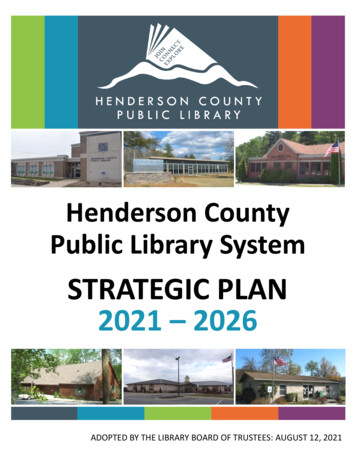
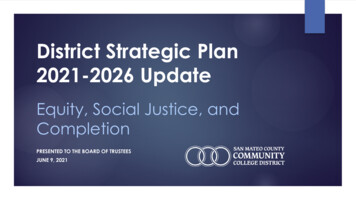
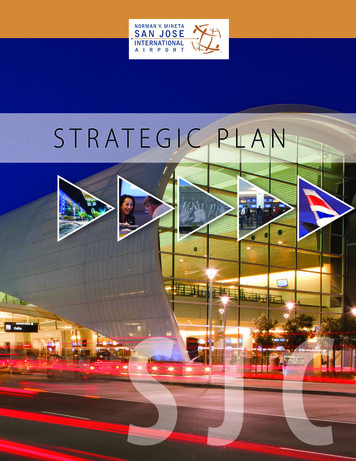

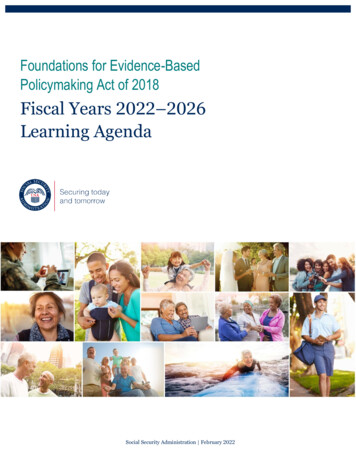

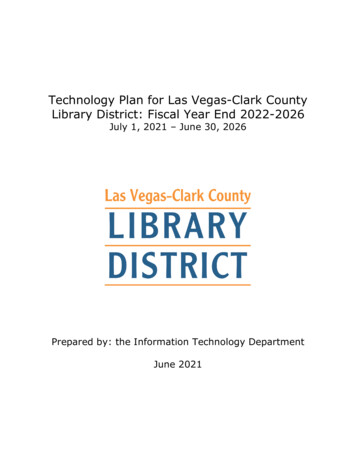

![[2017-2021 STRATEGIC PLAN ] - John Bel Edwards](/img/25/20172021lasubstanceabusepreventionstrategicplan.jpg)
